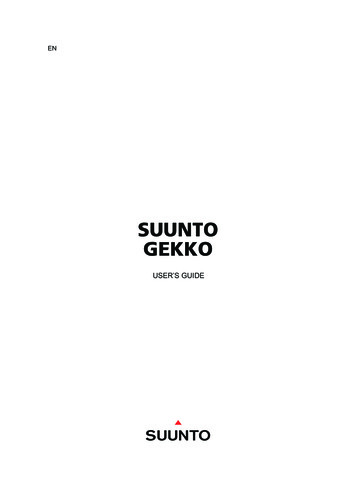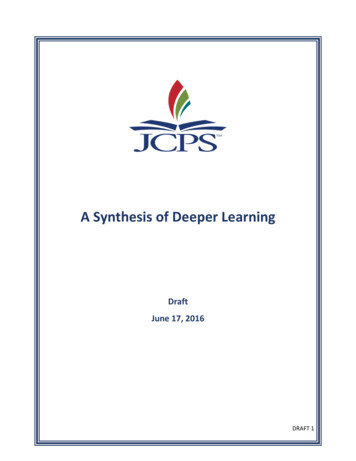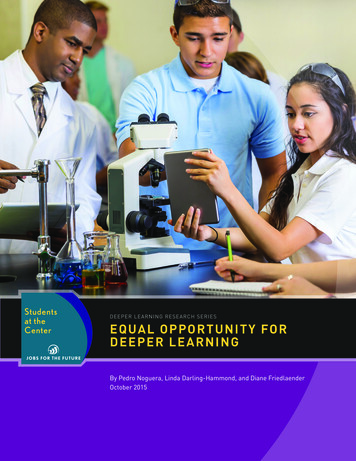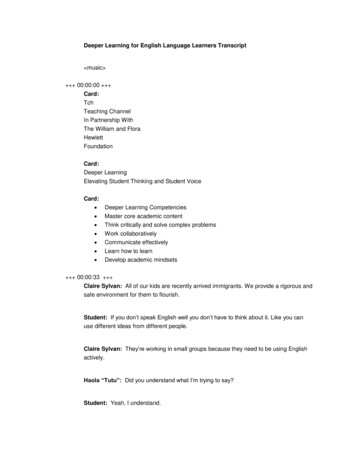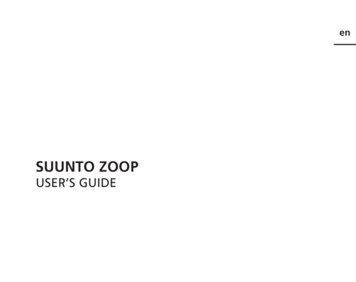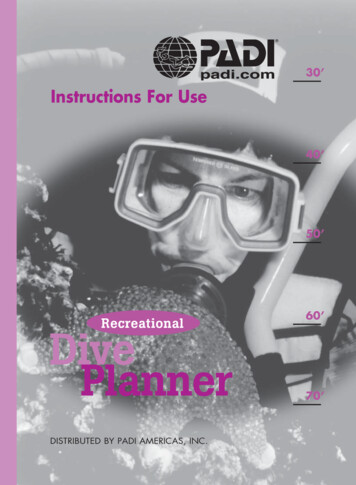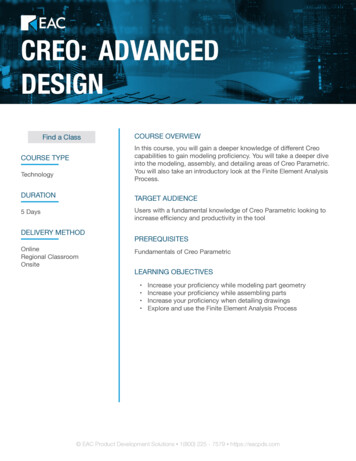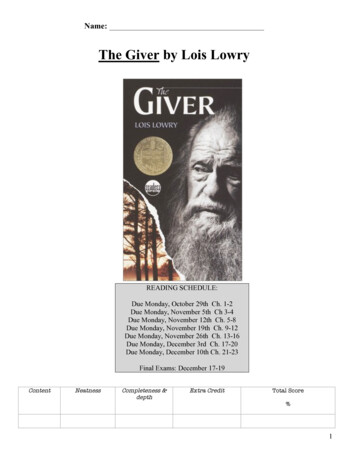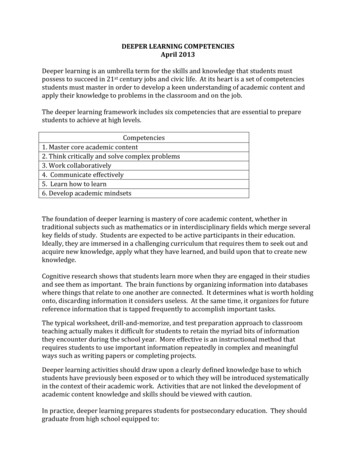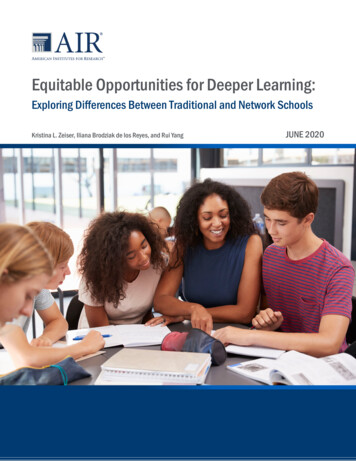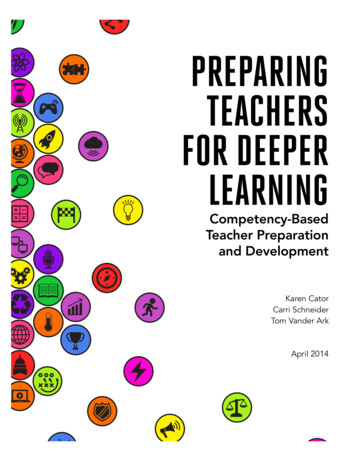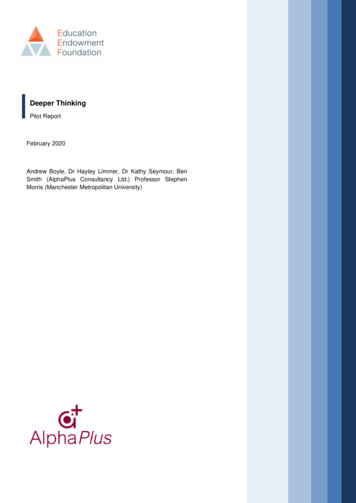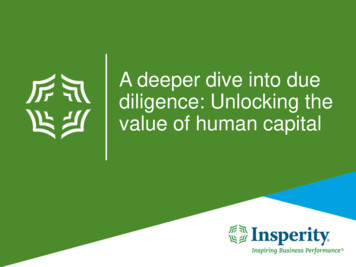
Transcription
A deeper dive into duediligence: Unlocking thevalue of human capital
Today’s presenterChelsea L. Wood,MA (I/O Psychology)Certified Merger & Acquisition AdvisorHR Consultant, Traditional Employment OperationsInsperity 2
ObjectivesBy the end of this session, you will be able to: Identify tips for successful due diligence Understand what is included in HR due diligence Identify the critical HR factors for adding value to anorganization Develop a potential roadmap for HR due diligence3
What is the point of conductingdue diligence?To evaluate therisks and identifyoperationalopportunities4
Robust due diligence Lower riskHigher valueMore secure investment
Refresher tips for successfuldue diligenceOrganization is critical: Use a virtual dataroom whenever possible Make sure it’s structured in an intuitive manner. Make sure your security settings are established.Preparation is key Seller: Have your house in order to facilitate timelydue diligence. Buyer: Make sure you know what you’re asking for andwhen it needs to be requested.6
Refresher tips for successfuldue diligenceConduct a phased approach Phase 1: Preliminary due diligence – typically focusedsolely on financials and fit to determine go/no-godecision. Phase 2: Document review – more extensive duediligence to identify operational risk as well as financialrisk. Phase 3: Operational review – typically includes onsitevisit and interviews with key stakeholders.Engage HR in the beginning of thetransaction7
It’s not the businessitself that providesexceptionalcustomer serviceor generatesgreat new ideas orgenerates revenue.It’s the people.8
HR due diligence basics:Recommended documentsWhat should be included? Employment agreementsConsulting agreementsCompensation plans (bonus, incentive, stock plans)Employee benefit plansInsurance contracts Job descriptions Disciplinary documentation for the last 12 months9
HR due diligence basics:Recommended documents Ongoing or past lawsuits based on harassment,discrimination or safety Employee turnover rate/open positions Retention agreements Full employee data file with job title, start date, status,salary, last increase, bonus target, most recent payout,and eligibility for other compensation Organizational chart Separation agreements10
“Mergers and acquisitions fail when HR decides to workonly with the other company’s HR to match up processesand policies. They don’t get to know the businesses, thesynergies or the culture. That’s how you can reallydestroy a great acquisition – when you lose the intrinsicvalue of the acquired company. It falls to HR to preservethat intrinsic value.”– Troy CromwellGroup President, Global Strategic ServicesVerizon gation/pages/berelevant.aspx
Illustrative purposes onlyHow much are these companiesworth?Company A5-7X15 years oldInjection moldingCompany for SaleValuationCompany ageProductCompany B5-7X15 Years OldInjection molding 40MSales 40M 4MEBITDA 4MModerateMarket growthModerateUndevelopedManagement teamExtensive and developedNoneHuman capital planThorough cascaded planOutdatedPolicies and proceduresFinely tunedExists by defaultCultureCultivated and owned by allPunishment for errorsSafetyEngrained in operationsHigh turnoverNoneReactive, event-triggered12TurnoverLeadership developmentTrainingCompany-specificrisk factors:Human capital directly impacts all of these!Minimal voluntary turnoverStructured programStructured annual training plan
Assessing themanagement team
How involved was the president/CEO in day-to-day decisionmaking?a. Practically every decision is made by them.b. Majority of all operational decisions are madeby them.c. They only approve major decisions.d. They are kept informed of major decisions and/orconsulted by the leadership team.14
Assessing the management team:Does the value lie with them or thepresident/CEO?1.2.3.4.5.6.7.8.15How much is operational knowledge distributed amongcompany leaders?How are decisions made?Do leaders have autonomy to run the business?Are they capable of running the business in the president’sabsence?Is there a clear succession plan in place?Are the managers developed?What are the strengths and weaknesses of theexisting management team?Are there any members who could potentiallycarry risk?
How to evaluate management teamriskKey questionsLower valueHigher value(higher risk)(lower risk)How much is operationalDay-to-day operationsknowledge distributed among are managed by acompany leaders?single leader or fewleaders.Actively engaged managersunderstand the performance of theorganization as a whole beyondtheir respective discipline.How are decisions madewithin the organization?Managers are empowered to makedecisions impacting their teams.16Decision-makingresides within a singleleader or a few (likelythe CEO or COO).
Does the management teammatter?17
Evaluatingpolicies and procedures
Which would you feel goodabout purchasing?19
Is there a standard way ofoperating within the organization?1.2.3.4.5.20Are there standard operating procedures for the day-today activities?Do they have documented HR policies and procedures?Are these HR policies and procedures actually practicedor are they just on paper?How frequently are the HR policies and proceduresreviewed and updated to reflect changes?Are there basic policies and procedures around safety,workplace violence prevention, harassment prevention,evacuation procedures, time off, meal times, companyholidays, disciplinary processes, attendance, work hours,etc.?
How to assess policies &proceduresKey questionsAre foundational HRpractices and policies inplace (e.g., employeehandbook, employeefiles, job descriptions,time-off procedures,anti-harassment, etc.)?21Lower valueHigher value(higher risk)(lower risk)There are limited oroutdated HR policies andprocedures that are noteasily identified or locatedby employees. Somepractices and policies maybe in conflict with federaland state employmentregulations.Standardized HR policies,procedures and practices arein place. All HR proceduresand policies reflect bestpractices. Someone staysabreast of state/federalemployment laws. There is anannual review that includesany needed updates.
Evaluating thehuman capital plan
Do they have a strategic humancapital plan?1.2.3.4.5.6.7.23Is there a clearly understood strategic direction?Are there clear goals that have been cascaded through alllevels of the organization?Have there been projections done related to workforceneeds as the organization continues to grow?Is there a clear plan in place for how the employees willbe supported in order to achieve organizational goals?Has HR been used to develop systems and practices tosupport the organization’s growth?Is data collected and monitored to inform progress towardgoals?Have critical roles and high-performers been identified?
How to assess risk related tohuman capital planningKey questions Lower valueHigher value(higher risk)(lower risk)Is staffingevaluatedand planned for inadvance?Staffing levels are evaluated aspositions are vacated and filled onan as-needed basis with no directconnection to budgeting.Staffing is reviewed regularly(e.g. annually, prior to a majorevent). Workforce changes arebudgeted in support of keystrategies.Have highperformersbeen identified?Are there effortsin place tomaintain them?There is no documentation orshared knowledge of critical players,but they can be identified quickly byCEO/COO/Owner. There areanecdotal references about keyemployees being loyal to theorganization with no strategies tomaintain them.There is a clear list of keyemployees required to continuethe organization’s success.Motivation, risk factors andretention strategies have beenidentified to retain critical talent.24
Leadershipdevelopment
Are leaders a valued asset drivingthe future of the organization orsimply a pair of hands?1.2.3.4.5.6.7.26Has there been any investment in developing the leaders of theorganization?Are there clear lines of advancement through theorganization for high-performers?What steps have been taken to identify, develop and promote highperformers?How are leaders supported to grow and develop their leadership skills?How are leaders engaged in day-to-day operations and improvementefforts?Is development a portion of the organizational budget?Do the leaders drive their own development, or are opportunities dictatedto them?
How to assess leadershipdevelopmentKey questions Lower valueHigher value(higher risk)(lower risk)How are leaderssupported to growand develop theirleadership skills?Future development is not a topicof discussion, but rather how theleader is completingresponsibilities and tasks on aregular basis. No cleardevelopment goals.Career goals have beenidentified and serve as a topicduring regular performanceconversations, with necessaryresources allocated to supportthese goals.Are leadersprovided withclear growthopportunities?Growth opportunities are not afocus. Mindset may be that if aleader wants to grow, thenadditional responsibilities may beadded without the resources tosucceed.There is a clear succession planthat has been communicated withspecific areas of development andresources to prepare the next levelof leaders for future roles.27
Turnover
How much turnover is experienced,and how is it managed?1.2.3.4.5.6.7.8.29What is the average turnover over the last 12 months?What is the average voluntary turnover (resignations) in the last12 months?How many high-performers resigned in the last 2 months?Of the turnover in the last 12 months, how many resigned in thefirst 30 days 60 days 90 days year?What is the average tenure of the employees?How do current employees describe the work environment tonew hires?How are positions filled? How many open positions are there?Do they conduct exit interviews? If so, what themes or patternshave been identified from those interviews? Have there beenany actions based on that feedback?
How to evaluate turnoverKey questions Lower valueHigher value(higher risk)(lower risk)How muchturnover isexperienced?There is a high level ofunanticipated turnover and/orconsistent/expected highturnover with no proactive planto address.There is a low level ofunanticipated or voluntaryturnover.What is therecruitingprocess?Positions are filled as they arevacated with no standardprocess or clear outline of anideal candidate based onorganizational fit and technicalskill. Top leadership hires allemployees as opposed to directmanagers and time-to-fill isn’tplanned for.There is a standardized processwith defined criteria for idealcandidates, trained interviewersusing consistent and compliantquestions, andtime-to-fill is proactively budgetedfor and included in workforceplanning models.30
Training
How has the organization invested inthe employees?1.2.3.4.5.6.7.32How are new employees trained?Do employees receive regular training?Is training monitored and tracked consistently?Does the organization have funds set aside foremployee development in the annual budget?What training have employees received in the last12 months?Have employees had the necessary training to ensurecompliance with federal, state and localdiscrimination/harassment requirements?How are employees trained on organizational policies?new programs/policies/practices?
How to evaluate employeedevelopmentKey questions Lower valueHigher value(higher risk)(lower risk)How are newemployeestrained?They start and then learn as theygo.They are oriented through astructured onboarding programfocused on organizational,department and job function.Do employeesreceive regulartraining?Informal training methods areused with training provided on anad-hoc basis. No mandatorytraining is in place.Training requirements are outlinedfor each position (new hire training,annual training, ongoingdevelopment, etc.).33
Evaluating workplace safety
How does the organization ensure asafe and secure work environment?1.Are there clearly communicated safety practices and policies in place?2.How are events managed (recorded, investigated, communicated,mitigated, etc.)?3.What is the safety record from the past 12 months?4.Do they have any recurring safety issues that have not been addressed?5.Are there any employees who have multiple safety infractions or accidents?6.How are new hires trained about safety practices?7.What is the process for addressing safety issues? Is it punitive or focusedon identifying root causes?8.Are employees provided with all the necessary safety equipment?9.Are they proactively or reactively planning for ergonomics and safety?35
How to assess risk related tosafetyKeyquestionsLower valueHigher value(higher risk)(lower risk)Are there clearlycommunicatedsafety practicesand policies inplace?There is a generic feeling thatthe organization is “safe.” Thereare no specific practices inplace for monitoring.Safety is a clear focus of theorganization. The organization strivesto comply with state/local safetyregulations. Standardized proceduresare documented, communicated andconsistently practiced.How are eventsmanaged?(recorded,communicated,mitigated, etc.)Events are managed as theyoccur with no standard processfor preventing, monitoring,communicating or following up.There may be action taken, butit is not consistently followedand may not be as robust asnecessary to prevent futureliability.Established safety processes exist forpreventing, as well as handling, eventsas they occur. Includes steps such asfiling event record, notification ofrequired parties, establishing anynecessary follow-up, and integratingchanges to prevent similar futureerrors.36
What about culturaldue diligence?
“What about culture everyoneknows culture is important, too,right?”Culture is a by-product of how anorganization chooses to operate.38
Is an investment worth 40,000or 100,000?39
Human capital factors that impactoverall valueLower valueHigher value(higher risk)(lower risk)Management teamUndeveloped and underutilizedExtensive and developedPolicies andproceduresInconsistent, undocumentedpracticesFinely tuned; establishedHuman capital planNo defined planThorough cascaded planLeadershipdevelopmentNo defined developmentStructured programTurnoverHigh voluntary turnoverMinimal voluntary turnoverTrainingReactive; event-triggeredStandard annual training planSafetyReactive; punished for errorsProactive; engrainedthroughout operations40
Critical considerations for buyingor selling any organization 41Strong management teamSolid foundation of standard policies and proceduresStrategic human capital plan in placeClear leadership development resourcesProactively managed turnoverStructured training programClearly engrained safety efforts
Questions?
Thank you for joining us!For more information, or to speakwith an Insperity businessperformance consultant, visitinsperity.com/acg or email us atalliance@insperity.com
time-off procedures, anti-harassment, etc.)? There are limited or outdated HR policies and procedures that are not easily identified or located by employees. Some practices and policies may be in conflict with federal and state employment regulations. Standardized HR policies, procedures and practices are in place. All HR procedures
